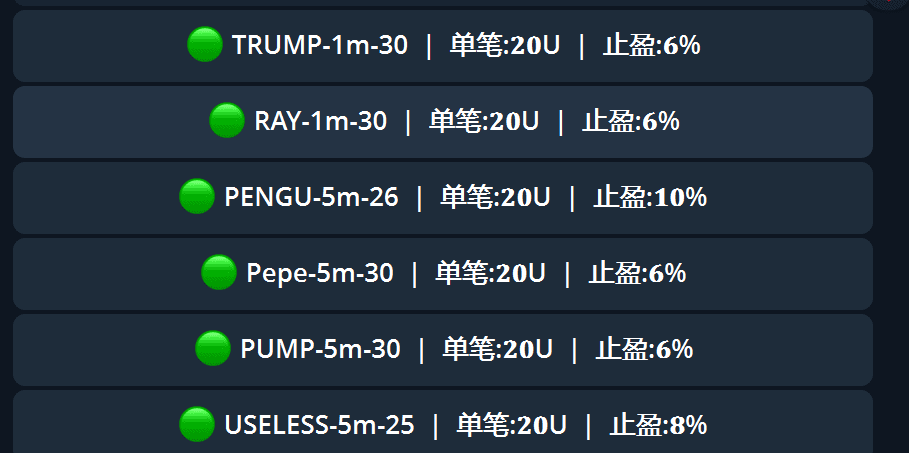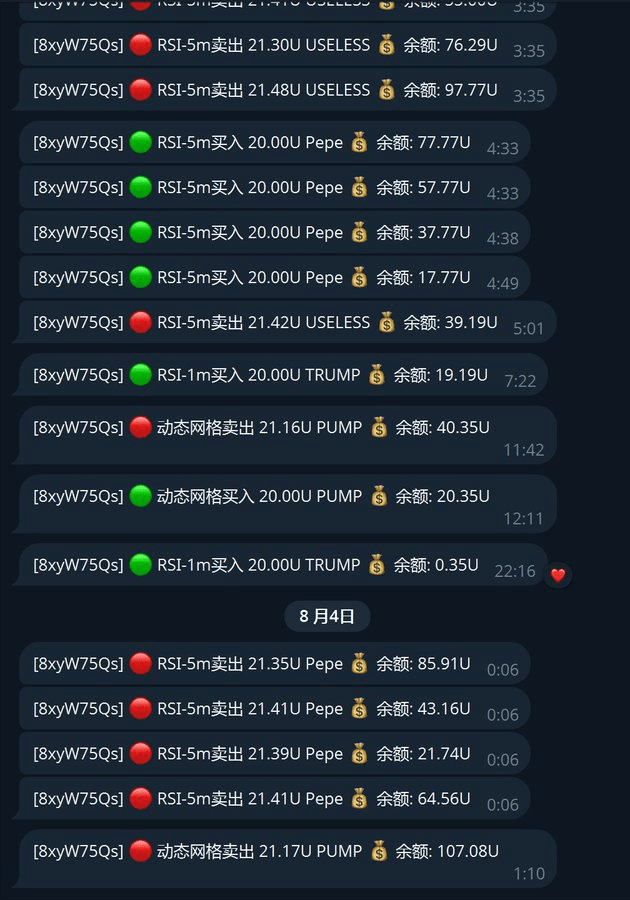Today's real trading is 4.7%, can 500U's theoretical data at the end of the year multiply?
📊 Daily Report 2:
Realized profit +16 USDC, unrealized floating surplus about +10 USDC, total +26 USDC. Wallet balance fluctuates. Highest 588.84.
Daily ROI = 26 ÷ 556.5 ≈ 4.7%.
Calculation: cost is 556.5 USDC, average price about 0.047 USDC/unit.
The above data is the result of an RSI + dynamic grid strategy!
What did you do last night?
Selected 5 different types of currencies:
1. pepe is well-known, an old coin with community building.
2. trump is also well-known, mainly selected because it is familiar. Large volume.
3. ray has a large volume, stable, trading over 20K in 5 minutes.
4. pengu has a large volume, stable, trading over 20K in 5 minutes.
5. pump has a large volume, stable, trading over 30K in 5 minutes.
Add a dynamic grid strategy: pump 6% take profit.

There's a minor correction:
I only traded 500U + 0.2SOL.
There were 4 reminders of insufficient funds.
It means I missed 4 buying opportunities today!
Because I was considering testing the BOT, I didn't add to my position! Test for a week, understand the patterns before adding positions!
Want to see the details of my tested strategy, or want to try this Bot?
You can come in to observe, first check the tutorial, and we can communicate together!
TPBot: https://t.me/follow_step_bot?start=DxRfw242
Tutorial: tpbot-2.gitbook.io/tpbot
The Bot's grid strategy function has only opened two CA for testing.
First, learn about grid strategies!
What is a grid strategy?
It doesn't predict trends, but repeatedly executes 'buy low, sell high' within a preset price range.
Set buy and sell orders equally within the range; each price level triggers arbitrage.
Very suitable for currencies that are range-bound but frequently volatile.
🧪 Theory vs Practice
Traditional static grids expect returns ≈ 0 (Zero EV) under ideal assumptions.
Dynamic Grid-based Trading (DGT) can significantly outperform fixed grids and 'buy and hold' strategies through algorithmic adjustments, offering greater flexibility!
🔍 Return decomposition formula:
Profit per grid ≈ price difference × quantity – fees.
Today: Two trades generated 40 USDC with a profit of 2.33 ⇒ 5.8% daily return.
If this happens daily, it could yield an astonishing annualized rate (hypothetical), but fees, market depth, and price volatility uncertainty may lower actual performance.
📌 Key Points for Parameter Settings:
Price range width: it is recommended to base it on historical volatility range, plus a buffer of 10-20%.
Grid step: each interval should be slightly larger than the total of fees + slippage, otherwise no profit.
Dynamic grid ≥ Fixed grid, especially during volatility clustering, can better capture arbitrage opportunities.
⚙️ Real Source of Profit:
Volatility clustering causes frequent trading triggers.
Difference in fees between Maker vs Taker (passive orders have lower costs).
Real trading is different from backtesting: backtests usually assume zero slippage and infinite liquidity, but real trading can be affected by delays and insufficient depth.
Tested in real market for several days, with different currency selections.
⚠️ Risk Warning:
🚨 When the range is broken, it may fall into a trending market, orders may be washed out, and profits may abruptly stop.
Accumulated fees from high-frequency trading.
Illiquid small coin pairs (MEME, altcoins) have a higher risk of slippage.
Bot execution delays and interface failures can also cause significant losses; this is currently being tested!
Grid strategies are not trend-following; they are suitable for 'swing repeated arbitrage' during oscillating phases.
Today the entire process +26 USDC has been verified: small investment + high frequency low risk = stable profit.
🎯 Operation Suggestion: Test with a small amount first, then optimize parameters (based on sharpe/MaxDD), do not blindly increase positions.
In the future, it can combine multiple currency pairs and long-term backtesting to create a dynamic grid model that suits oneself.
This Bot is just a tool; it is still human nature and rhythm that truly determine profits and losses.
Chasing highs and cutting lows is the thinking of retail investors.
Buying dips and selling rallies is the thinking of market makers.
Clarify your thoughts, let the robot execute, and continuously iterate on your ideas!
Next, I will share some insights in the group.
Thought processes for selecting currencies and clearing positions can be discussed among interested brothers.

#OnChain #DogChasing #TradingStrategy #Bot #zenmusk
#GridTrading #Crypto #QuantitativeTrading #震荡套利



